I love a freshly baked scone and these Lemon Blueberry Scones are a great flavour combination. Serve them warm, straight from the oven with butter, clotted cream and blueberry jam or lemon curd - delicious!
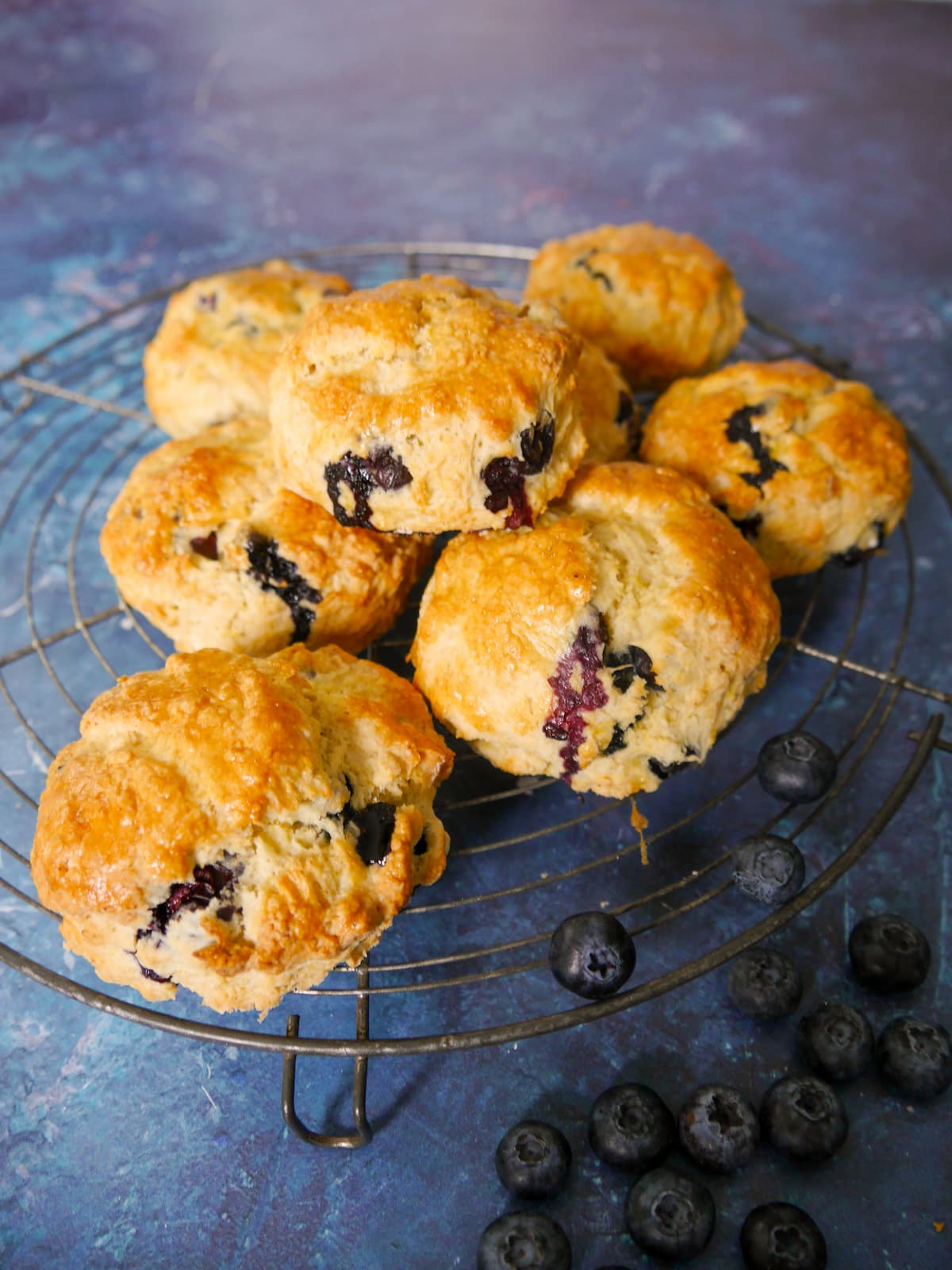
I've used my basic Buttermilk Scone recipe as a base, then added in the additional flavourings. I like to add finely grated lemon zest and fresh blueberries to the scone dough.
I bake a good scone however, I have friends who say that they struggle to bake a decent scone. Some complain about the lack of rise, others say their scones are tough.
Scone dough needs a light hand, so it's important not to overwork the dough mixture! Within this recipe post I will explain the process and give you my top tips for baking the perfect scone!
Why you'll love this recipe
- A change from a plain scone, the combination of pear and ginger is delicious and something a little different.
- Scones are a quick bake, once prepared they take very little time to bake and can be enjoyed warm, straight from the oven!
- Feed a crowd as this recipe can be easily doubled up.
Recipe ingredients
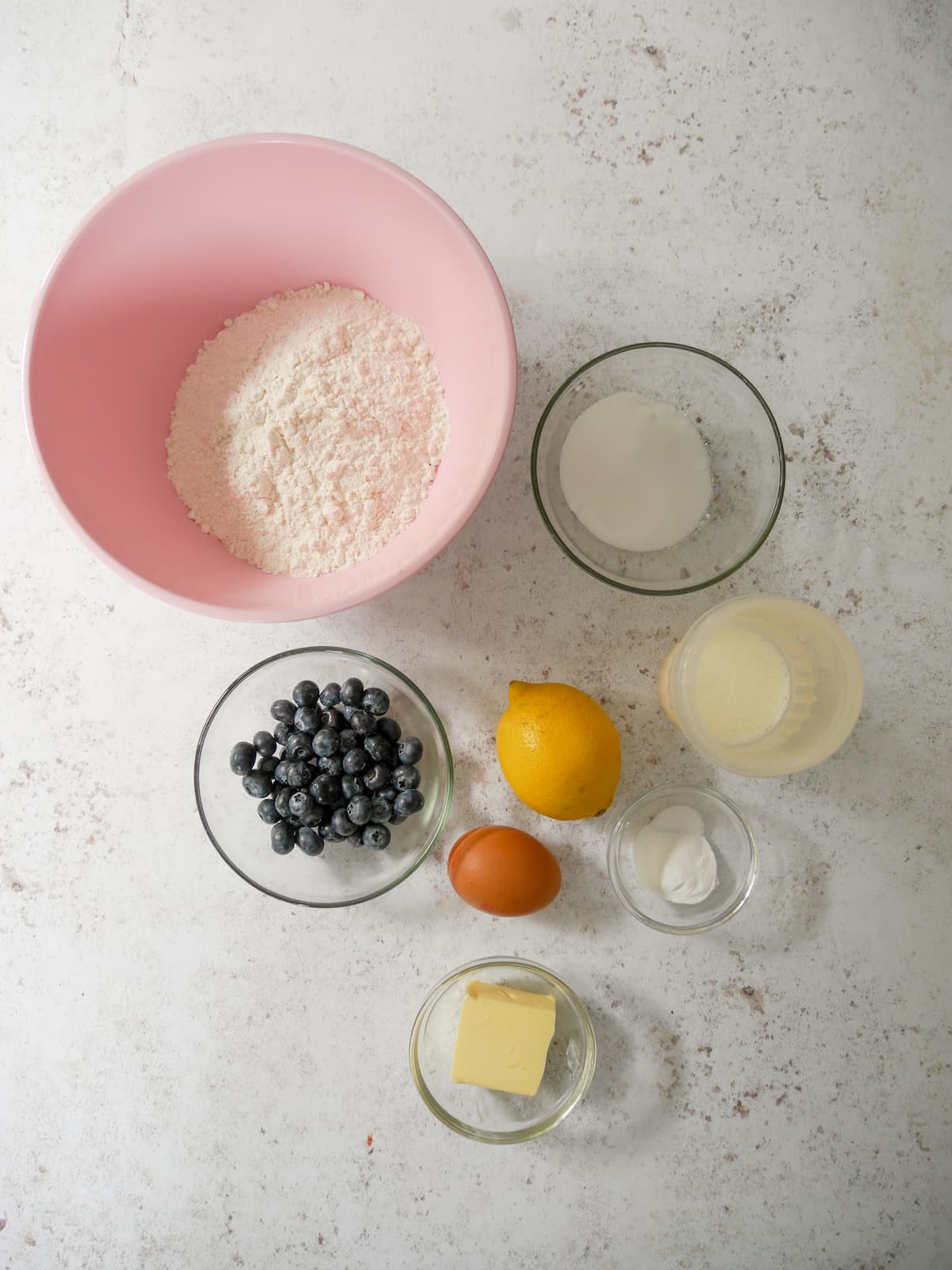
- Flour - I use self raising flour to make the scones, with a little extra for dusting my work surface.
- Sugar - I used caster sugar in the scone dough.
- Baking powder - I add 1 teaspoon of baking powder when baking scones with added fruit as this helps give the scones a little extra rise.
- Salt - I always add a pinch of salt which helps balance out the sweetness.
- Lemon - I add the finely grated zest of a lemon to the scone dough.
- Blueberries - I've opted to use fresh blueberries in this recipe, but you could use frozen berries, or dried blueberries if you prefer. If using dried berries I recommend soaking them in some hot water first to soften them, then dry them thoroughly before adding to the dough.
- Butter - when baking scones I use unsalted butter. If using salted butter leave out the pinch of salt in the dry ingredients.
- Egg - egg enriches the flavour and texture of the scone dough. I use a large free range egg to make the scone dough, plus an extra egg to brush over and glaze the scone before baking.
- Buttermilk - I like to use buttermilk when baking scones as I think it results is a better, more tender scone.
How to make lemon and blueberry scones
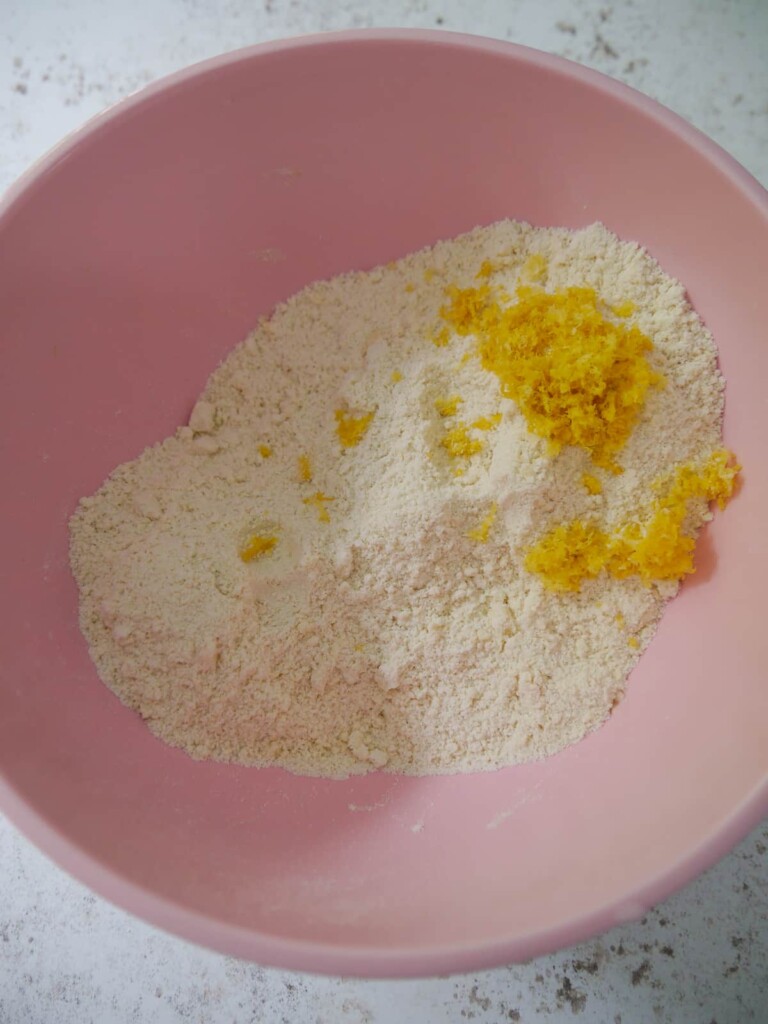
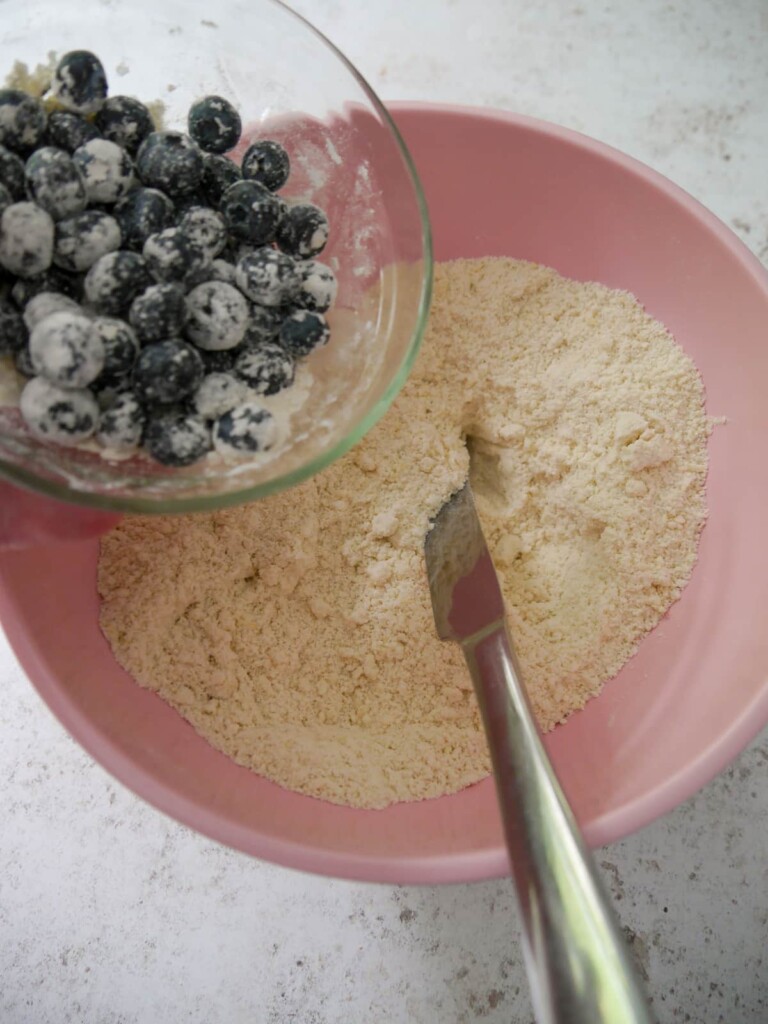
- Preheat the oven to 220°C/200°CFan/390F. Line a baking sheet with a silicone mat or baking parchment.
- Place the flour, sugar, baking powder and salt into a mixing bowl and stir to combine.
- Add the butter and rub it into the flour mixture with your fingers until it resembles fine breadcrumbs. Work quickly as you don't want the butter to warm up and melt.
- Toss the blueberries in a tablespoon of flour to coat them. Doing this stops the blueberries from sinking to the bottom of the scones while baking.
- Now add the lemon zest and blueberries into the dry ingredients and stir well to combine.
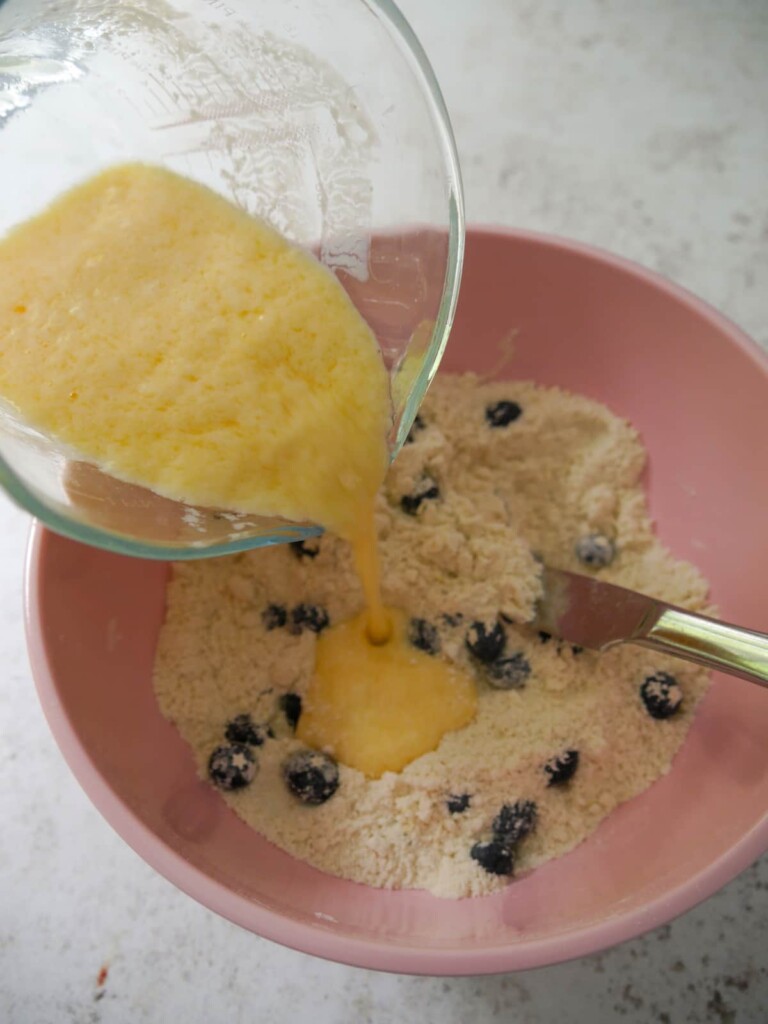
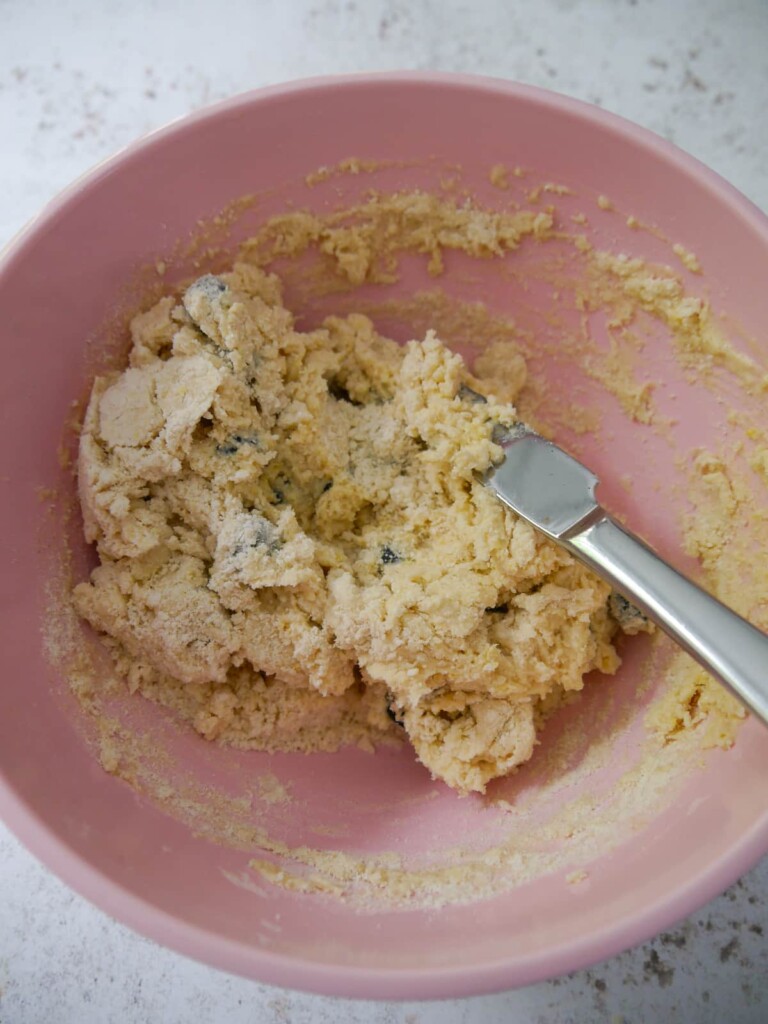
- In a measuring jug, mix the egg with the buttermilk.
- Add the egg mixture into the dry ingredients and mix gently with a fork or knife, just enough to bring the mixture together into a dough.
LESLEY'S TIP: Do not knead over overwork the dough! No only will this make the dough tough, but it will also burst the blueberries.
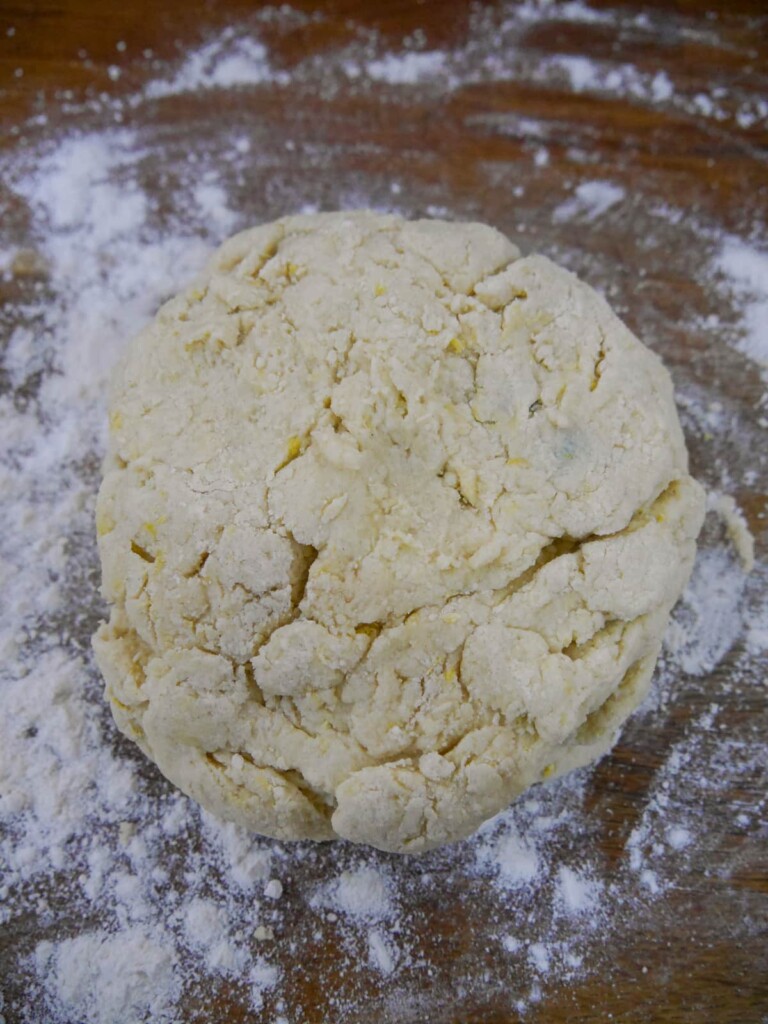
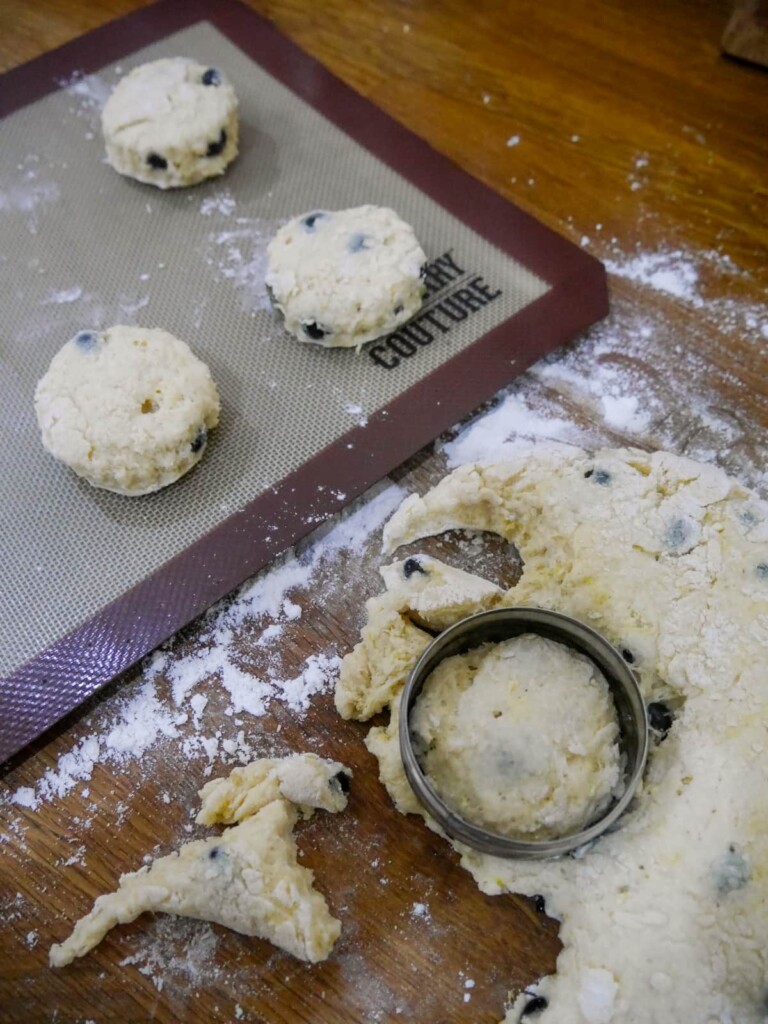
- Turn the dough out onto a well floured work surface and gently pat down to 2.5cm (1").
- Cut the scones with a scone cutter or knife to the desired shape and size. Cut the first round of scones then gently bring the leftover dough together again before cutting more scones until all the dough has been used.
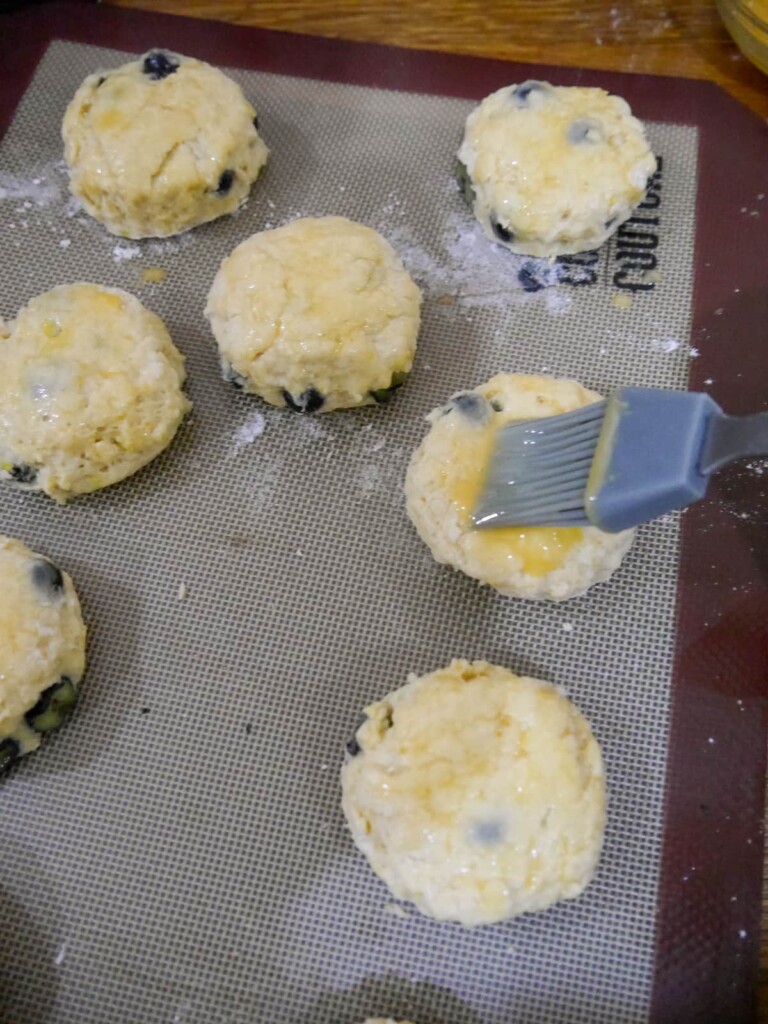
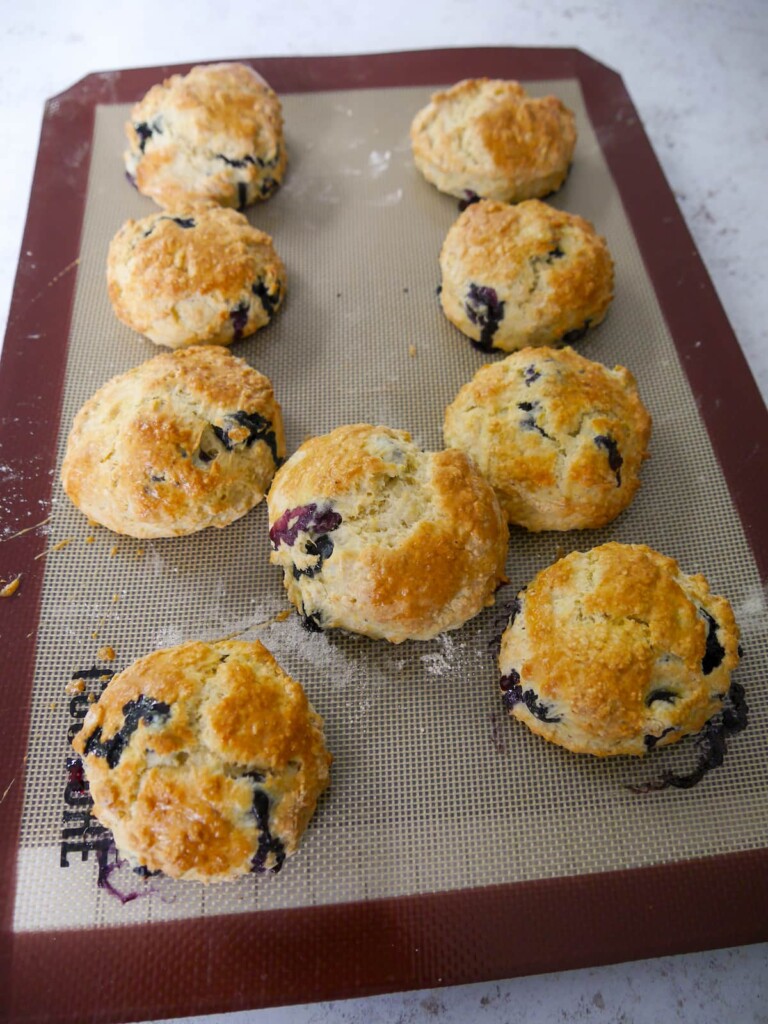
- Place the scones onto the baking sheet and brush the top of each scone with egg wash or milk.
- Place the scones into the warm oven and bake for 16-18 minutes until golden. Note that cooking times will vary depending on the size of the scone cutter used. I used a 6cm (2 ½ inch) scone cutter.
- Remove the scones from the oven and place on a wire rack to cool for 5-10 minutes before serving.
The secret to making good scones!
There are a few basic rules that you need to follow if you want to bake light and fluffy scones.
- When rubbing the butter into the dry ingredients, use the tips of your fingers to form a breadcrumb like consistency and work quickly to keep the butter cool. If you use your whole hand it will warm up the butter and melt it, leaving you with something unworkable.
- When bringing the dough together I like to use a fork, a knife, or sometimes just my fingers. Take care not to be too heavy handed, you're only trying to pull the ingredients together into a rough ball.
- Once combined into a rough ball, place on a very well floured surface to stop the dough from sticking. Gently press down until the dough is 2.5cm/1" in depth. I prefer to do this rather than using a rolling pin which can flatten the scones too much. If using a rolling pin add a generous amount of flour to that too.
- Do not knead the dough! If you overwork the dough it will not rise, you will be left with flat, hard scones. The less you work the dough the better the rise and the fluffier the scone.
- Cut the first round of scones then gently bring the leftover dough together again before cutting more scones.
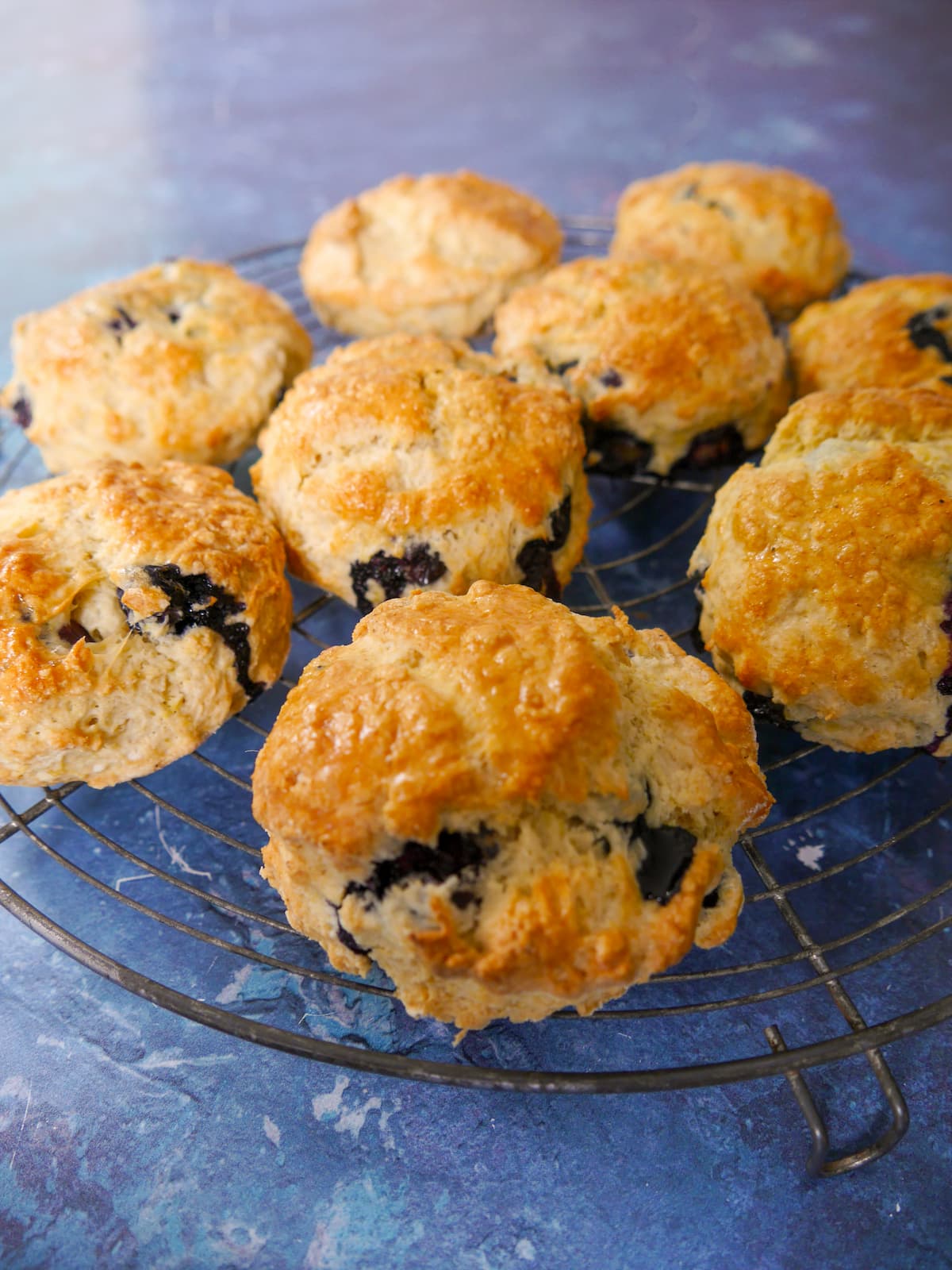
Recipe variations
- Buttermilk - I like to use buttermilk in scones as it has a nice acidity which balances the sweetness. You could swap the buttermilk for whole milk if you prefer.
- Citrus - swap the lemon zest for orange or clementine zest instead.
- Spices - add some dried spices like ground ginger or cinnamon to the scone dough.
- Glaze - I like the scones as they are, but if you want to glaze the scones, combine some freshly squeezed lemon juice with icing sugar (powdered sugar) and drizzle over the top of the scones once they have cooled. Don't do it sooner or the icing will melt and slide off.
Serving suggestions
When it comes sweet scones, I like to serve them with butter, clotted cream and jam. In this case I've opted for blueberry jam, but lemon curd would be a great alternative.
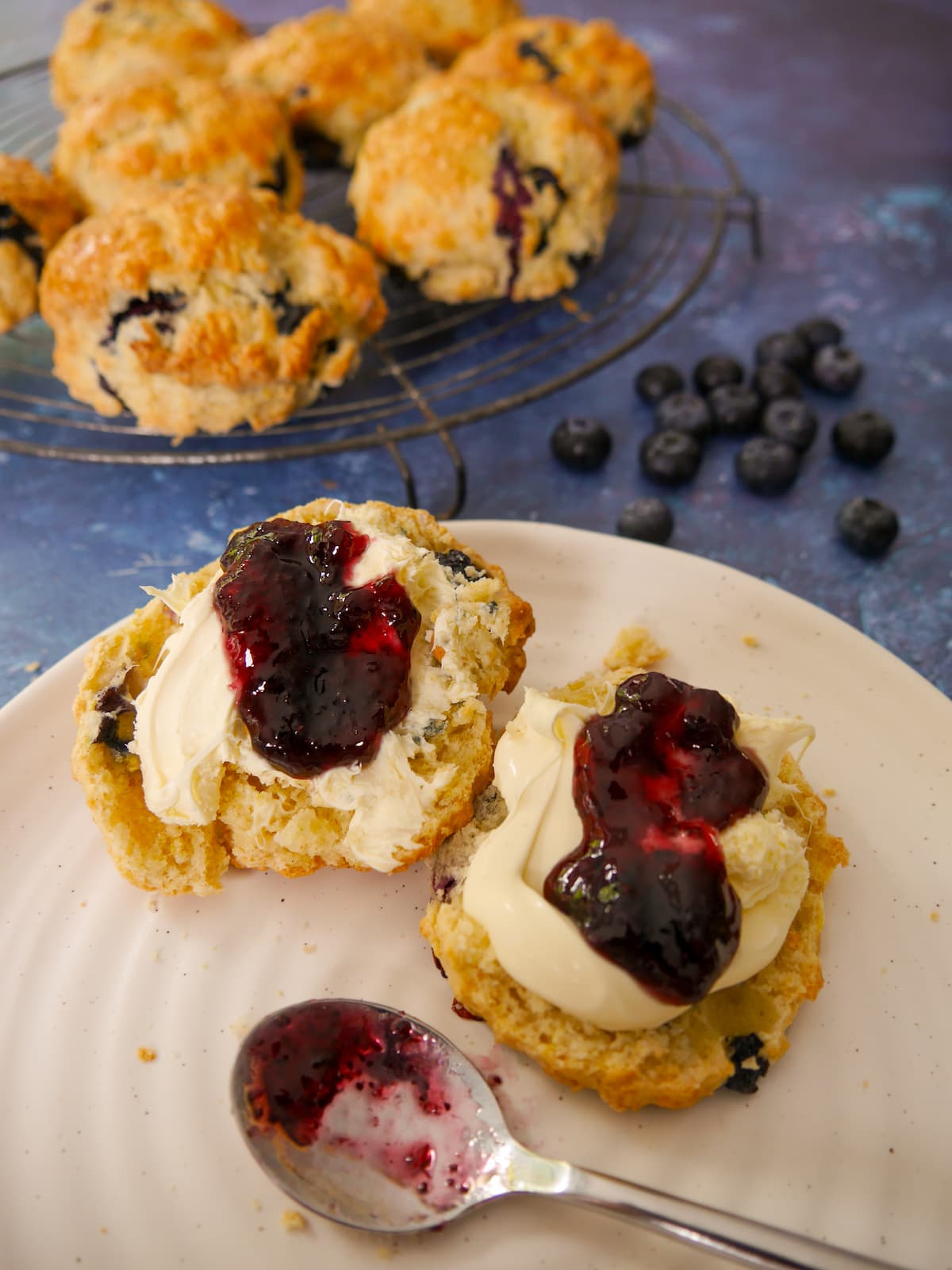
Useful hints and tips
- Buttermilk: buttermilk in the UK is quite thick, if you are using milk, you may need to reduce the quantity.
- Adapt baking times: baking times will vary depending on your oven, and also the size of the scone cutter used.
- Equipment: If you don't have a scone cutter, use the bottom of a glass or cup to shape the scones. Alternatively use a sharp knife to cut the scones.
- Allergy advice: soya free and nut free. For comprehensive and detailed allergy advice go to Allergy UK.
FAQs
When flavouring scones with other ingredients that might weigh them down (eg fruit, cheese, etc) I like to add a little baking powder to the scone mix to help the dough to rise. However, do not be heavy handed with the baking powder add only the 1 level teaspoon asked for in the recipe. Anything more will result in a scone that tastes terrible. Add just enough to get the scones to lift.
Scones are best eaten when warm and fresh from the oven, the day they are baked. They will keep another day or 2, stored in an airtight container, but past 2 days they start to taste a bit stale. A quick heat up in the microwave or oven does help soften them.
Yes, scones freeze really well, so you can take out and enjoy at a later date. When freezing scones, simply allow to them to cool completely and place into an airtight container suitable for the freezer. When taking your scones back out of the freezer they are best when warmed up a little in the oven before serving.
Pin the recipe

Additional recipe suggestions
If you like this recipe then try some of my other scone recipes:
- Buttermilk Scones
- Apple & Cinnamon Scones
- Pumpkin Spiced Scones
- Savoury Cheese Scones
- Cheese & Jalapeno Scones

Lemon Blueberry Buttermilk Scones
Equipment
- large mixing bowl
- weighing scales
- Measuring jug
- measuring spoons
- Fork or knife to bring dough together
- Scone/cookie cutter
- Baking sheet
- Silicone liner or baking parchment
Ingredients
- 300 g self raising flour (plus extra for dusting worksurface)
- 50 g caster sugar
- 1 teaspoon baking powder
- 1 pinch salt
- 50 g unsalted butter
- 1 lemon zested (finely grated zest)
- 80 g blueberries
- 1 large free range egg (plus one extra egg, beaten to make an egg glaze to paint over the scones before baking)
- 100 ml buttermilk
Instructions
- Preheat the oven to 220°C/200°CFan/390F. Line a baking sheet with a silicone mat or baking parchment.
- Place the flour, sugar, baking powder and salt into a mixing bowl and stir to combine.
- Add the butter and rub it into the flour mixture with your fingers until it resembles fine breadcrumbs. Work quickly as you don't want the butter to warm up and melt.
- Toss the blueberries in a tablespoon of flour to coat them. Doing this stops the blueberries from sinking to the bottom of the scones while baking.
- Now add the lemon zest and blueberries into the dry ingredients and stir well to combine.
- In a measuring jug, mix the egg with the buttermilk.
- Add the egg mixture into the dry ingredients and mix gently with a fork or knife, just enough to bring the mixture together into a dough. DO NOT OVERMIX OR KNEAD THE DOUGH!
- Turn the dough out onto a well floured work surface and gently pat down to 2.5cm (1").
- Cut the scones with a scone cutter or knife to the desired shape and size. Cut the first round of scones then gently bring the leftover dough together again before cutting more scones until all the dough has been used.
- Place the scones onto the baking sheet and brush the top of each scone with egg wash or milk.
- Place the scones into the warm oven and bake for 16-18 minutes until golden. Note that cooking times will vary depending on the size of the scone cutter used. I used a 6cm (2 ½ inch) scone cutter.
- Remove the scones from the oven and place on a wire rack to cool for 5-10 minutes before serving.
Notes
- Do not overwork the dough or it will result in tough, dense scones. Use a light touch and only handle the dough enough to bring together.
- Liberally flour your work surface to stop the dough from sticking.
- The buttermilk in the UK is quite thick, if you are using milk, you may need to reduce the quantity.
- Baking times will vary depending on the size of the scone cutter used.
- If you don't have a scone cutter, use the bottom of a glass or cup to shape the scones. Alternatively use a sharp knife to cut the scones.
• Please note that the nutrition information provided above is approximate and meant as a guideline only •


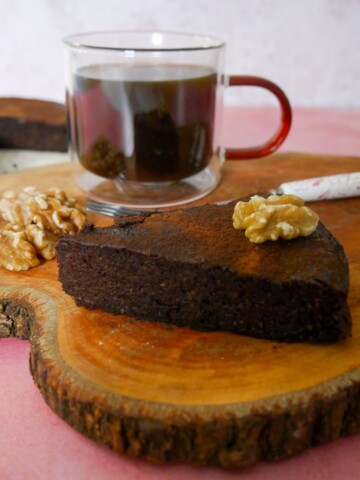
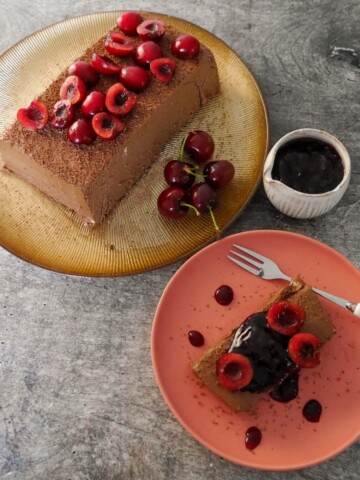
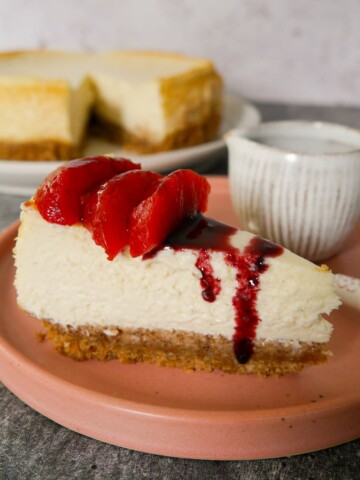

Chloe says
Such a good flavour combo and I loved how the blueberries kind of pop when you bite in!
Lesley says
Thank you Chloe, I love the pop of fresh blueberries in these scones.
Tricia says
There don’t seem to be any quantities given for the ingredients in this recipe
Lesley says
Hi Tricia, I think you might be looking at the part of the post where I give a bit more information about the ingredients I use, eg whether I use salted or unsalted butter. I do not include the quantities at this point. The recipe quantities are listed within the recipe card at the bottom of the post - there's a "Jump To" button at the top to get you there. In the recipe card you will find all the quantities for each ingredient, directly under the list of equipment you will need to make the scones.
Janice says
What a great flavour combination! We loved how the lemon offset the sweet blueberries, I'll definitely be making them again.
Lesley says
I'm really glad you enjoyed the scone recipe Janice, it's a lovely flavour combination.